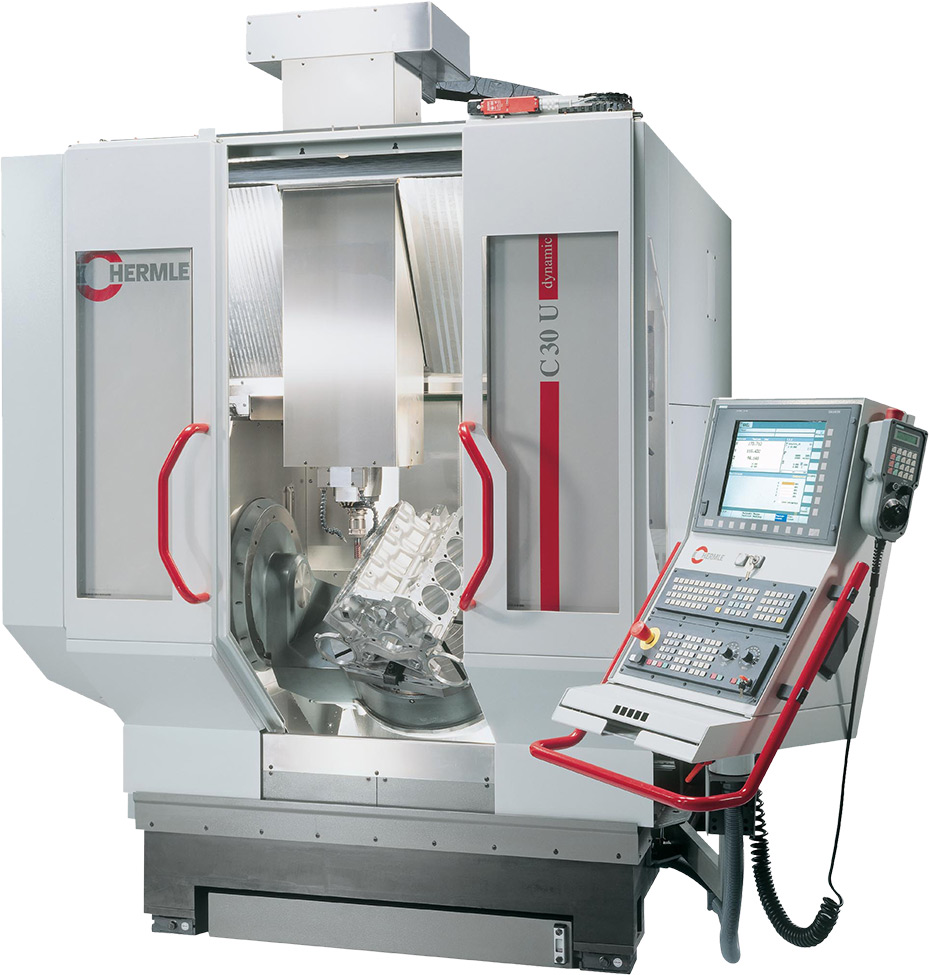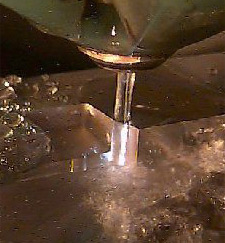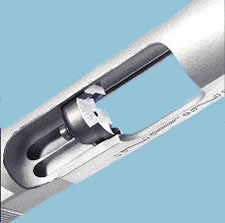Home | Glossary | Resources | Help | Contact Us | Course Map
Archival Notice
This is an archive page that is no longer being updated. It may contain outdated information and links may no longer function as originally intended.
Computer Numeric Control Machining
Computer Numeric Control (CNC) machining has revolutionized manufacturing in many fields. CNC is a form of computer-aided manufacturing (CAM) that combines many processes (drilling, turning, milling, etc.) into one multifunction machine. Because the floor space (footprint) required for one CNC machine is a fraction of that required for multiple work stations, output is significantly increased without sacrificing quality.
CNC machining is best suited for mass production where many identical items are required. A CNC machining center requires minimal operator intervention for routine operation; one operator can manage several work centers simultaneously.
In CNC machining, a computer program describes the position of features (physical characteristics) to be machined. Typically, a reference point on the raw stock is identified as 0, 0, 0 in three-dimensional Cartesian coordinates. All other features are referenced from this starting point. The CNC machine has multiple tool holders and can choose the tool needed for producing a specific physical feature in the final work product. Advanced machines have tool storage magazines. The machine chooses the correct tool specified by the program instruction, installs it in a tool holder, and cuts the feature.
Once the program is completed, the machine may require an operator to install a new piece of raw stock and manually restart the process. Automated units perform without operator intervention. A stock feed system holds a supply of raw parts and the programmed input includes the total number of parts to be processed.
More advanced CNC devices incorporate CAD/CAMcomputer-aided design/computer-aided manufacturing.
The process includes the following stages:
- The engineer or drafter draws the part required in three dimensions using drafting software; all dimensions that define the part are included.
- The drawing is sent directly to the CNC center where other software
- converts the common engineering dimensions to Cartesian coordinates,
- determines which cutting tools are needed,
- establishes the most efficient order of operations to produce the desired part.
With traditional manufacturing, the raw forging would go to one machine for initial shaping and then be passed to successive machines for additional machining. These machines take up floor space and require an operator. Each operator must remove the part from the set-up for measurement several times before it is ready to move to the next machining step. Fabricating the same part with CNC technology can be accomplished with one or two machines and a single operator. The cost savings are tremendous, and the quality of the part is better because human error in the downstream operations is virtually eliminated.
See the YouTube Terms of Service and Google Privacy Policy
Electrical Discharge Machining
Electrical discharge machining (EDM) uses an electrical arc between a shaped electrode and the work surface to burn away material to a predetermined shape. In firearms manufacture, EDM is most commonly used for the production of holes or cavities with complex shapes.
Steps in the EDM process are as follows:
- The electrode is formed to the shape needed and inserted in a pilot hole.
- Current is applied to the electrode and arcs across the gap between the electrode and the work material.
- The metal erodes to the shape dictated by the electrode.
Hand Fitting
Depending on the design of the firearm, some parts may need individual adjustment to properly fit with other parts. Hand fitting is an extension of fine-forming operations and usually requires filing, stoning (fine grinding with a hand tool), and pressure fitting the parts.
The firearm examiner may encounter hand-fit surfaces when examining breechface markings produced by revolvers. After the manufacturer fits the cylinder to the revolver, the gap between the cylinder and breechface may require adjustment by filing. Filing is an operation that cannot be performed the same way twice. Chips in the file produce random marks, and the file wears a little with every pass. This results in a distinctive pattern of microscopic marks.
Rifled Barrels
This discussion of manufacturing focuses primarily on the firearm components that most commonly lend individuality to firearms and make identification possible.
The firearm component that started modern forensic identification is the rifled barrel. The modern barrel starts as a solid bar of steel. Conventional chromium-molybdenum (chrome-moly) steels have been the norm for over a century, but various alloys classed as stainless steel have appeared in increasing numbers over the last thirty years. The difference in material has little bearing on identification. For the manufacturer it is important because stainless steel machines differently from chrome-moly steel and may require different tooling and processing.
Firearms manufacturers may own their barrel-making equipment or buy partially completed barrel blanks. The old norm was to own all the equipment needed to make a firearm. Newer global trends in manufacturing reflect that buying parts reduces the significant capital investment required to produce in-house.
Additional Online Courses
- What Every First Responding Officer Should Know About DNA Evidence
- Collecting DNA Evidence at Property Crime Scenes
- DNA – A Prosecutor’s Practice Notebook
- Crime Scene and DNA Basics
- Laboratory Safety Programs
- DNA Amplification
- Population Genetics and Statistics
- Non-STR DNA Markers: SNPs, Y-STRs, LCN and mtDNA
- Firearms Examiner Training
- Forensic DNA Education for Law Enforcement Decisionmakers
- What Every Investigator and Evidence Technician Should Know About DNA Evidence
- Principles of Forensic DNA for Officers of the Court
- Law 101: Legal Guide for the Forensic Expert
- Laboratory Orientation and Testing of Body Fluids and Tissues
- DNA Extraction and Quantitation
- STR Data Analysis and Interpretation
- Communication Skills, Report Writing, and Courtroom Testimony
- Español for Law Enforcement
- Amplified DNA Product Separation for Forensic Analysts





